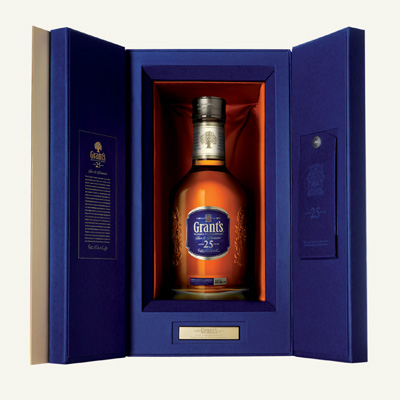Art of crafts
Premiumisation is one way to build a brand, and creating high-quality, limited-edition products with customised packaging usually does the trick. David Benady reports on a design sector that focuses on old-fashioned crafts, but not at the expense of the brand story

Designers are sharpening their knowledge of craft skills as luxury brand-owners commission super-premium packaging for limited-edition runs of spirits, perfumes and leather goods.
Hand-crafted packaging fulfils a desire to escape the synthetic world of mass production and calligraphy, leather working, goldand silversmithing, glass blowing, cabinet making, embossing and engraving are all being dragooned into the creation of exquisite structural packaging.
This is providing a boost for craft masters such as calligrapher Peter Horridge, gold and silversmiths at Thomas Fattorini and leather maker Ettinger.
Much of the demand for limited-edition runs is fuelled by Asia’s new rich. But while some wealthy consumers are looking to boost their status through conspicuous consumption, others are true connoisseurs, searching for the highest quality.
John Mathers, managing director of Holmes & Marchant, which has created luxury packaging for perfume brand Grossmith, warns, ’Limited editions have become overused and misused. They must have value and incredible desirability. There are many examples of faux limited editions which lack the demonstration of craft skills.’
If you’re selling a rare, 50-year-old whisky, the packaging is expected to reflect the craft behind the product. Whisky maker William Grant asked The Brand Union to create bespoke packaging for its Glenfiddich 50-year-old whisky, with a run of 50 bottles each year until the end of the barrel. Each bottle is hand-made by a glass blower – a time-consuming process as some of the bottles come out slightly wonky and have to be junked – and bears a solid silver, hand-engraved label. The bottle comes in a hand-stitched, filigree-effect leather case which is debossed. Sold through Global Duty Free at £10 000 a bottle, some customers will pick up a couple of bottles, one to keep as a collector’s item and the other to drink with friends. Glenn Tutssel, executive creative director of The Brand Union, says the secret to creating highly crafted packaging is developing a thorough knowledge of craft processes and the people who excel at them. Tutssel adds, ’My first design studio in Soho in the 1970s was surrounded by button makers, gunsmiths, violin makers and specialist craft shops. They were making products on the premises, not just showcasing them. You could talk to the leather maker or button stitcher, and they had a thorough knowledge of their craft. Most of that is gone now.’
Craft excellence is in decline in the UK as the old skills die out, and there is a dearth of apprenticeships for new craftspeople. In addition, young designers tend to shy away from the traditional skills.
However, there is still a strong heraldic tradition surrounding the monarchy and aristocracy, and these expert crafters are available for packaging projects.
Nude partner Bernard Gormley says authenticity is key for demonstrating heritage and tradition to discerning buyers. He adds, ’These skills still very much exist in the UK, which is where we employ craftspeople for limited editions, but when you start going into bigger runs of thousands you have to look overseas to places like China to produce them.’
Not all limited editions are exclusively for the super rich. For larger runs, such as Grant’s 25-year-old whisky, much of the craft work is carried out in the Far East. Ian Smith, structural design director at LFH, which created the design, advises designers to employ modelmakers. ’Sending over a model of exactly what you want tends to get around the language barrier. Factories often try to cut costs, so you need to show them exactly what you are looking for,’ he advises.
But there is more to packaging luxury limited editions than simply employing the finest craftspeople. Stuart Humm, design director at Coley Porter Bell, says, ’It’s the stories behind the brands that are so important. If you just shoe-horn crafts together you can end up in trouble.’
Some have pointed to the Jagger Dagger – a £5000 topaz-studded silver ice pick designed by Jade Jagger for Belvedere Vodka in 2008 – as an example of a gratuitous product extension that fails to chime with the brand’s values.
In contrast is Lewis Moberly’s recent design for Glenmorangie Finealta whisky, a limited-edition recreation of a recipe from the early 1900s that was discovered in a warehouse ledger at the distillery. This sense of rediscovering part of a brand’s history was central to creating successful limited editions that seemed rooted in the product’s back story.
In the field of perfumes, the craft skills of glass-blowing are still much in demand. Holmes & Marchant worked with Simon Brooke, the great-great grandson of John Grossmith, to recreate the 19th-century fragrance brand of the same name.
Brooke uncovered one of the original Grossmith perfume bottles, which he identified as originating from Paris glass-blower Baccarat. He took the bottle to Baccarat, which discovered that it still had the original mould and was able to recreate the bottle. A limited edition of the scents in crystal bottles is being launched with gold etching designed by Holmes & Marchant on the front of each bottle.
A flood of limited-edition luxury whisky brands, cognacs and vodkas is expected next year, providing welcome work for master craftspeople. But designers must avoid being blinded by the beauty of the crafts and ensure they let the brand story shine through.
-
Post a comment




